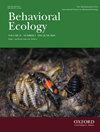Intrinsic and extrinsic factors modulating vigilance and foraging in two gregarious foragers
IF 2.2
3区 环境科学与生态学
Q2 BEHAVIORAL SCIENCES
引用次数: 0
Abstract
A continuous balance between costs and benefits dictates individual vigilance and foraging dynamics. In group-living animals, understanding the resulting trade-off is often complicated by multiple confounding effects. Vigilance and foraging levels may be the result of intrinsic (e.g., body size, trophic ecology, migratory phenology) and extrinsic (e.g., flock size, edge effect, group dynamism) factors, potentially differing between species, individuals, and contexts. We explored this idea by investigating intrinsic and extrinsic factors influencing vigilance and foraging behavior of two sympatric gregarious bird species that differ markedly in body size and foraging strategies (Greylag Goose Anser anser and Common Crane Grus grus), during their non-breeding period. Interspecific differences were detected in activity allocation and in response to group-related variables. For both species, time spent in vigilance decreased with increasing flock size and with increasing distance from the edge of the group. While cranes allocated the resulting time to foraging, the same did not occur in geese. Changes in individual position in the group (i.e., peripheral vs. central or vice versa) elicited a prompt behavioral change (i.e., vigilance vs. foraging or other activity). Temporal changes in activity budgets were reported for geese but not for cranes, with a decrease of vigilance and an increase of foraging as winter progressed. Results allowed to disentangle the role of multifactorial determinants of vigilance and foraging, in turn increasing our understanding of underlying forces driving the evolution of behavioral traits and of group-living.调节两种群居觅食者警惕性和觅食的内在和外在因素
成本与收益之间的持续平衡决定了个体的警惕性和觅食动态。在群居动物中,对由此产生的权衡的理解往往因多种混杂效应而变得复杂。警惕性和觅食水平可能是内在因素(如体型、营养生态学、迁徙物候学)和外在因素(如鸟群大小、边缘效应、群体活力)共同作用的结果,不同物种、个体和环境之间可能存在差异。我们通过研究影响两种体型和觅食策略明显不同的同域群居鸟类(灰雁和普通鹤)在非繁殖期的警惕性和觅食行为的内在和外在因素,对这一观点进行了探索。在活动分配和对群体相关变量的反应方面发现了种间差异。对于这两种鹤来说,随着鹤群规模的扩大和与鹤群边缘距离的增加,用于警戒的时间也会减少。鹤将由此产生的时间分配给了觅食,而雁的情况并非如此。个体在群体中位置的变化(即外围与中心或反之)会引起及时的行为变化(即警戒与觅食或其他活动)。鹅的活动预算发生了时间变化,但鹤的活动预算没有发生变化,随着冬季的到来,鹅的警惕性降低,而鹤的觅食活动增加。研究结果有助于厘清警戒和觅食的多因素决定因素的作用,从而加深我们对行为特征和群居生活进化的内在驱动力的理解。
本文章由计算机程序翻译,如有差异,请以英文原文为准。
求助全文
约1分钟内获得全文
求助全文
来源期刊

Behavioral Ecology
环境科学-动物学
CiteScore
5.20
自引率
8.30%
发文量
93
审稿时长
3.0 months
期刊介绍:
Studies on the whole range of behaving organisms, including plants, invertebrates, vertebrates, and humans, are included.
Behavioral Ecology construes the field in its broadest sense to include 1) the use of ecological and evolutionary processes to explain the occurrence and adaptive significance of behavior patterns; 2) the use of behavioral processes to predict ecological patterns, and 3) empirical, comparative analyses relating behavior to the environment in which it occurs.
 求助内容:
求助内容: 应助结果提醒方式:
应助结果提醒方式:


